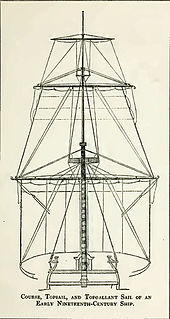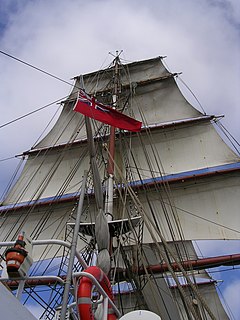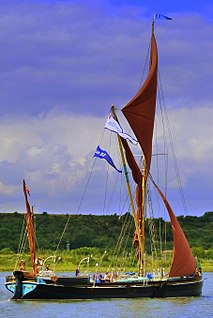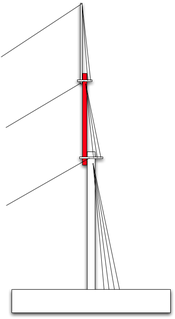
A sloop is a sailboat with a single mast typically having only one headsail in front of the mast and one mainsail aft of (behind) the mast. Such an arrangement is called a fore-and-aft rig, and can be rigged as a Bermuda rig with triangular sails fore and aft, or as a gaff-rig with triangular foresail(s) and a gaff rigged mainsail. Sailboats can be classified according to type of rig, and so a sailboat may be a sloop, catboat, cutter, ketch, yawl, or schooner. A sloop usually has only one headsail, although an exception is the Friendship sloop, which is usually gaff-rigged with a bowsprit and multiple headsails. If the vessel has two or more headsails, the term cutter may be used, especially if the mast is stepped further towards the back of the boat.

A sail plan is a description of the specific ways that a sailing craft is rigged. Also, the term "sail plan" is a graphic depiction of the arrangement of the sails for a given sailing craft.
A jib is a triangular sail that sets ahead of the foremast of a sailing vessel. Its tack is fixed to the bowsprit, to the bows, or to the deck between the bowsprit and the foremost mast. Jibs and spinnakers are the two main types of headsails on a modern boat.

A topsail ("tops'l") is a sail set above another sail; on square-rigged vessels further sails may be set above topsails.

A cutter is a type of watercraft. The term has several meanings. It can apply to the rig of a sailing vessel, to a governmental enforcement agency vessel, to a type of ship's boat which can be used under sail or oars, or, historically, to a type of fast-sailing vessel introduced in the 18th century, some of which were used as small warships.

Gaff rig is a sailing rig in which the sail is four-cornered, fore-and-aft rigged, controlled at its peak and, usually, its entire head by a spar (pole) called the gaff. Because of the size and shape of the sail, a gaff rig will have running backstays rather than permanent backstays.

A Bermuda rig, Bermudian rig, or Marconi rig is a configuration of mast and rigging for a type of sailboat and is the typical configuration for most modern sailboats. This configuration was developed in Bermuda in the 1600s; the term Marconi, a reference to the inventor of the radio, Guglielmo Marconi, became associated with this configuration in the early 1900s because the wires that stabilize the mast of a Bermuda rig reminded observers of the wires on early radio masts.

Square rig is a generic type of sail and rigging arrangement in which the primary driving sails are carried on horizontal spars which are perpendicular, or square, to the keel of the vessel and to the masts. These spars are called yards and their tips, outside the lifts, are called the yardarms. A ship mainly rigged so is called a square-rigger.

A full-rigged ship or fully rigged ship is a sailing vessel's sail plan with three or more masts, all of them square-rigged. A full-rigged ship is said to have a ship rig or be ship-rigged. Such vessels also have each mast stepped in three segments: lower mast, top mast, and topgallant mast. Other large, multi-masted sailing vessels may be regarded as ships while lacking one of the elements of a full-rigged ship, e.g. having one or more masts support only a fore-and-aft sail or having a mast that only has two segments.

A Thames sailing barge is a type of commercial sailing boat once common on the River Thames in London. The flat-bottomed barges with a shallow draught and leeboards, were perfectly adapted to the Thames Estuary, with its shallow waters and narrow tributary rivers. The larger barges were seaworthy vessels, and were the largest sailing vessel to be handled by just two men. The average size was about 120 tons and they carried 4,200 square feet (390 m2) of canvas sail in six working sails. The mainsail was loose-footed and set up with a sprit, and was brailed to the mast when not needed. It is sheeted to a horse, as is the foresail; they require no attention when tacking. The foresail is often held back by the mate to help the vessel come about more swiftly.

The masts of traditional sailing ships were not single spars, but were constructed of separate sections or masts, each with its own rigging. The topmast is one of these.

The spritsail is a four-sided, fore-and-aft sail that is supported at its highest points by the mast and a diagonally running spar known as the sprit. The foot of the sail can be stretched by a boom or held loose-footed just by its sheets. A spritsail has four corners: the throat, peak, clew, and tack. The Spritsail can also be used to describe a rig that uses a spritsail.
Alexandria was a cargo-carrying three-masted schooner built in 1929. Originally named Yngve, she was built at Björkenäs, Sweden, and fitted with a 58 H.P. auxiliary oil engine.

On large sailing ships a spritsail is a square-rigged sail carried on a yard below the bowsprit. One of the earliest depictions of a spritsail is carved on Borobudur ship carving in Borobudur temple, Indonesia.
The following outline is provided as an overview of and topical guide to sailing:

SB Centaur is a wooden Thames sailing barge, built in Harwich, Essex, England in 1895. She was used to carry various cargoes, mainly grain, for the next 60 years. During the First World War she carried food and coal to the French Channel ports. During the Second World War Centaur was damaged when sailing to assist with the Dunkirk Evacuation. She did war work for the duration of the conflict.

The SB Kathleen was a spritsail Thames barge built by Glover at Gravesend, Kent, in England in 1901, and registered in Rochester. Her official number was 113,708. She was built to carry grain- for capacity rather than speed. she was 82.8 feet (25.2 m) long and had a beam of 19.7 feet (6.0 m). Light, she drew 30 inches (76 cm) of water, and laden 6 feet (1.8 m).

SB Decima is a steel Thames sailing barge constructed in Southampton in 1899 by J.G. Fay and Co, Southampton for E. J. Goldsmith of Grays, Essex. She is back under sail and resident on the River Darent in Dartford, Kent. She is a notable "Historic Ship".

George Smeed is a Thames barge built in 1882 by Smeed Dean & Co. Ltd. in Murston.
This is a glossary of nautical terms; an alphabetical listing of terms and expressions connected with ships, shipping, seamanship and navigation on water, but not necessarily on the sea. Some remain current, while many date from the 17th to 19th centuries. The word nautical derives from the Latin nauticus, from Greek nautikos, from nautēs: sailor, from naus: ship.
















